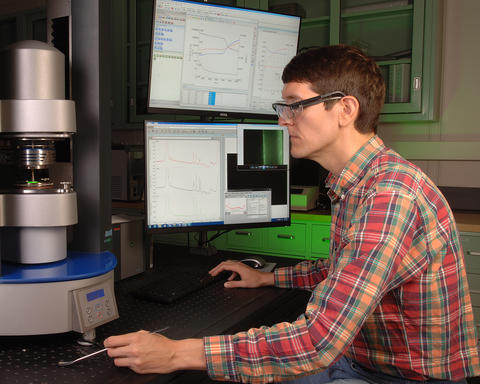
NIST’s Anthony Kotula using the new rheo-Raman microscope, a three-in-one instrument that enables researchers to measure the flow properties of a material along with its microscopic structure and composition.
An innovative three-in-one instrument that allows scientists to correlate the flowability of soft “gooey” materials such as gels, molten polymers and biological fluids with their underlying microstructure and composition has been developed by scientists from the National Institute of Standards and Technology (NIST) and Thermo Fisher Scientific.
Simultaneous measurements yield a clearer picture of how structural make-up and flow behavior during processing dictate the macroscopic properties—such as strength, hardness, or electrical conductivity—that make so-called soft materials desirable for certain products or applications.
A novel combination of off-the-shelf instruments, the new research tool—called the rheo-Raman microscope—integrates:
- a Raman spectrometer, which shines a laser on the sample and measures the tiny portion of scattered light that reveals vibrational energy levels of molecules in the sample, providing the equivalent of molecular fingerprints showing how atoms are arranged;
- a rotational rheometer to track and measure how a liquid, suspension or slurry flows in response to stress—or, put another way, the degree to which the sample deforms; and
- an optical microscope that collects polarized light reflected from a sample to increase contrast, enabling measurements of a specimen’s structural features at microscopic scales.
The new instrument is designed for “multitasking,” said Anthony Kotula, a NIST materials scientist. “It allows you to trace the evolution of microstructure across a range of temperatures and to do it in one controlled experiment rather than in two or three separate ones. It provides insights that would be very difficult to obtain through measurements made one at a time.”
Homing in on the flow behavior is especially important, because it is intimately coupled with the microstructure and ultimate properties, Kotula explained.
Soft materials share features of liquids and solids. They range from plastics to liquid crystal displays and from contact lenses to biopharmaceuticals. For these “in-between materials,” even slight variations in processing conditions can alter internal structures and drastically change material properties, which can open the way to improved performance or entirely new technological applications.
As they report in the Review of Scientific Instruments, the team used their prototype rheo-Raman microscope to follow and measure changes before, during and after melting a cosmetic material composed of coconut and almond oils and about 10 other ingredients. They also present simultaneous “melt” measurements taken on high-density polyethylene, which is used to make plastic bottles, corrosion-resistant pipes and many other items, as liquid molecules arrange and solidify into crystals.
Both demonstrations yielded a detailed, unfolding picture of how flow behavior and other phenomena during melting and crystallization correspond to changes in the shape and arrangement of molecules due to processing conditions.
“Based on the possibilities for direct correlation between chemical, structural and mechanical properties, we expect the rheo-Raman microscope to be critically relevant to both academic and industrial interests,” the researchers concluded in their article.
“The rheo-Raman microscope is a general purpose instrument with lots of potential uses,” Kotula said. “At NIST, one of our first applications pertains to 3D printing. We’ll use it to better understand how polymer crystallization proceeds during the layer-by-layer printing process.”
Article: A.P. Kotula, M. Meyer, F. De Vito, J. Plog, A.R. Hight Walker and K.B. Migler. The rheo-Raman microscope: Simultaneous chemical, conformational, mechanical, and microstructural measures of soft materials. Review of Scientific Instruments. October 4, 2016. DOI: 10.1063/1.4963746

